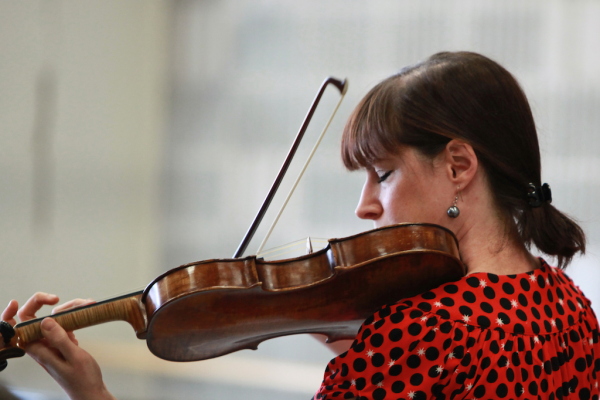This has to be one of the most bizarre pieces ever written. Based on the now debunked Old Testament story of the flight of the Israelites from Egypt and the destruction of the Pharaoh’s army with the parting of the Red Sea, it is inherently theatrical in so many respects, yet it clearly belongs in the church or concert hall as an oratorio.
 Madeleine Easton
Madeleine Easton
Performances are rare indeed – I can’t recall experiencing it before – mostly because of the extended role of the chorus. It is indeed odd for the chorus to carry the role of narrator in an oratorio. 26 of the 39 numbers in this score are assigned to the chorus, 18 of these for double chorus. The soloists, six of these in the present performance, are relegated to secondary status: three duets, four recitatives and five arias (much lower than, say, Messiah, which premiered two years later, in 1741).
The reason is simple, conductor and festival director Roland Peelman explains in his customary lucid and thought-provoking way. The real protagonist in this work is not the figure of Moses we associate with, say, Schoenberg’s opera Moses und Aron (only two of the projected three acts were completed when Schoenberg set it aside in 1932) or the overblown film cut-out figure of Charlton Heston in The Ten Commandments, Cecil B. DeMille’s blockbuster of 1958. The real protagonist is the people of Israel.
All the more remarkable that the chorus was the brightest star in this feature presentation of the Canberra International Music Festival. There were only 32 of them, but in the generous cathedral-like acoustic of the Fitters’ Workshop, it sounded as though there were at least another hundred.
The chorus was drawn from some of Canberra’s best choral singers, Coro, the Luminescence Chamber Singers and the Kompactus Youth Choir. With barely three rehearsals, the result was quite extraordinary. Especially so, as they stood throughout the entire performance – a few minutes short of two hours – with only one intermission to regroup.
The six soloists varied in quality, but it was the four men who impressed the most. I particularly enjoyed the vocal confrontation between the two basses (Andrew Fysh and Andrew O’Connor) in the bellicose duet The Lord is a man of war, almost Purcell in its floridity. More so the beauteous singing of male alto Tobias Cole, a much loved local singer and choral director, well known for his annual productions of Handel operas (on September 1 and 2, his group, Handel in the Theatre will present a production of Susanna in the Canberra Playhouse). His aria Thou shalt bring them in provided the most splendid singing of the evening.
A pity that the soloists did not join in the final chorus, Sing ye to the Lord, even if there was no room for them onstage. Their firepower would have had given added fury to this resounding if somewhat texturally inconclusive chorus.
From the opening number, with its orchestral echoes of both Messiah and Zadok, the Bach Akademie Australia were clearly in their element, relishing Handel’s witty and sometime mischievous word-painting. Yes, this is the yarn with all those pestilences – frogs, flies, hail and darkness – and the Akademie instruments (again tuned to A415) provided vivid colouration of Handel’s score.
After their Bach cantatas on Sunday morning, the Akademie, led by their splendid violinist-director Madeleine Easton, now found themselves on less familiar territory: a full Handel opera, and on precious limited rehearsal time. There were now about two dozen of them, pairs of period flutes, oboes, bassoons, trumpets, trombones, strings, timpani and continuo instruments of theorbo and the ever admirable Neal Peres Da Costa jumping between organ and harpsichord. When they walked down that long aisle to and from that crowded stage, it was hard not to be reminded of another Old Testament story: the animals of Noah’s ark, assembling two-by-two.
A couple of technological observations. A welcome development in the presentation of CIMF concerts this year has been the projection of texts and movement titles above the stage; if only the slides could remain to the end of the respective movements! More interesting still is the gradual appearance of tablets and iPads to replace printed music: there were a few in the choir and one of the male soloists sang his numbers from a tablet. Sign of the times, as a morning seminar will debate in a seminar devoted to music technology and notation, “Return to Basics” (Canberra Grammar School, 11.00am Friday 4 May).
Presiding over the entire exercise – a feat that could so easily have been a folly – was Roland Peelman, again coaxing, teasing, cajoling every syllable from the chorus, allowing not a single nuance to escape his notice. Straitened financial constraints no doubt necessitated this micro-managerial approach (how very Canberra!) where a more expansive overview might have been achieved in other circumstances.
Even so, this was a treat that will live long in Canberra’s memory. Far from perfect in its delivery and execution, this was nonetheless a truly festival event in every way. It afforded a rare view of one of the most bizarre creations from one of the most theatrical of Baroque composers, still finding his way through the unfamiliar thickets of the English language in his oratorios.











Comments
Log in to join the conversation.